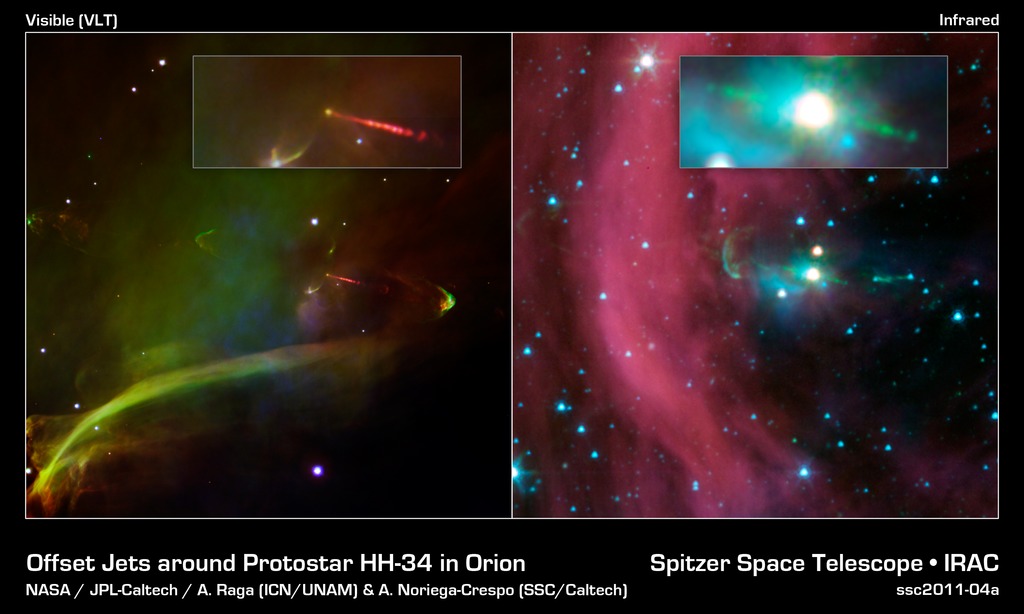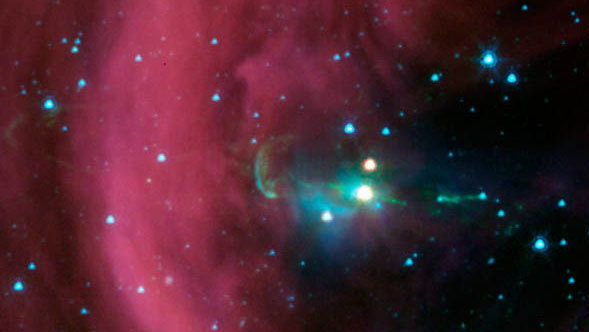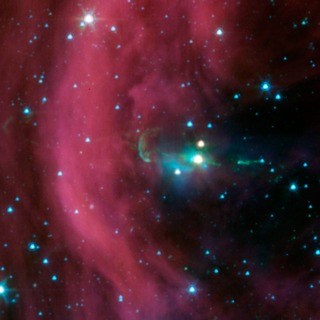
Credit: NASA / JPL-Caltech / A. Raga (ICN/UNAM) & A. Noriega-Crespo (SSC/Caltech)
Observation • April 4th, 2011 • ssc2011-04a
ssc2011-04a
This image layout shows two views of the same baby star -- at left is a visible-light image, and at right is an infrared image from NASA's Spitzer Space Telescope. Spitzer's view shows that this star has a second, identical jet shooting off in the opposite direction of the first. Both jets are seen in green in the Spitzer image, emanating from the fuzzy white star. Only one jet can be seen in the visible image in red.
The second jet is buried behind a dark cloud, and thus cannot be seen in visible-light images. Spitzer's infrared vision was able to show the jet in detail for the first time. Infrared light can penetrate dusty, dense clouds.
The Spitzer image shows that both of the twin jets, in a system called Herbig-Haro 34, are made up of identical knots of gas and dust, ejected one after another from the area around the star. By studying the spacing of these knots, and knowing the speed of the jets from previous studies, astronomers were able to determine that the visible jet (to the right of the star) punches its material out 4.5 years later than the counter-jet.
The new data also reveal that the area from which the jets originate is contained within a sphere around the star, with a radius of 3 astronomical units. An astronomical unit is the distance between Earth and the sun. Previous studies estimated that the maximum size of this jet-making zone was 10 times larger.
The wispy material in both views is gas and dust. Also, in both views, arc-shaped bow shocks can be seen at the ends of the twin jets. The shocks consist of compressed material in front of the jets.
The Herbig-Haro 34 jets are located at approximately 1,400 light-years away in the Orion constellation.
About the Object
- Name
- Herbig-Haro 34 • HH-34
- Type
- Star > Evolutionary Stage > Protostar
- Star > Circumstellar Material > Outflow
- Nebula > Type > Jet
- Nebula > Appearance > Dark
- Distance
- 1,500 Light Years
Color Mapping
| Band | Wavelength | Telescope |
| Infrared | 3.6 µm | Spitzer IRAC |
| Infrared | 4.5 µm | Spitzer IRAC |
| Infrared | 5.8 µm | Spitzer IRAC |
| Infrared | 8.0 µm | Spitzer IRAC |
Astrometrics
- Position (J2000)
- RA =5h 35m 30.2s
- Dec = -6° 26' 8.0"
- Field of View
- 6.8 x 6.8 arcminutes
- Orientation
- North is 90.0° left of vertical






